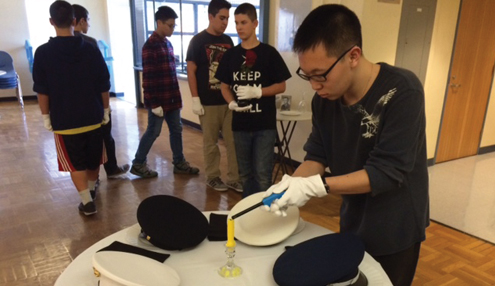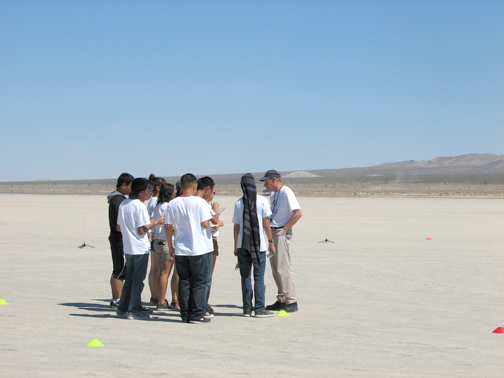
Members of the Crescenta Valley High School JROTC practice the powerful POW/MIA table ceremony.
Since its inception, the JROTC program has been building leadership skills and loyal friendships.
By Mary O’KEEFE
The Crescenta Valley High School JROTC has been a leadership program at the school for 27 years: however, its roots go much deeper. It was over 100 years ago when U.S. Army Lt. Edgar R. Steevers envisioned a strong citizenship and leadership program for high school students that has since become the nation’s JROTC.
Steevers planted its seeds in 1911 in Cheyenne, Wyoming. He envisioned a program aimed at making better citizens and to teach young men the advantages of having a strong body and mind, the value of self-control and the importance of community service, according to cvhsjrotc.com.
One way the program has evolved over the years, as has the military, is accepting women into the program. At Crescenta Valley High School, Lt. Col. Dave Worley is the AFJROTC teacher and mentor and is assisted by Senior Master Sgt. Billie Smith.
The mission of the JROTC is to “develop citizens of character, dedicated to serving their nation and community.” The program does this by reaching to the core of students by helping to build not only their leadership skills but to give them a place they feel safe with friends they can count on.
“I have been alone pretty much,” said Erin Russel, a CVHS freshman in describing her life at school.
When she was in the eighth grade, JROTC came to Rosemont Middle School and she heard, and saw, what the program was like. She knew it would help her build leadership skills but also thought it would be a good place to make friends.
“I used to be super shy and now I have met so many amazing people [in JROTC]. I feel like this is a great opportunity for anyone who feels left out or maybe that they don’t fit in,” she said.
The program welcomes all who are willing to show and learn respect.
There are classes where students learn about the history of aviation and even get to use the school’s new flight simulators. Students learn to appreciate the history of aerodynamics from the Wright brothers’ planes to modern planes.
One of the more visible segments of the JROTC is the color guard. The color guard is typically found at public functions including board of director installations for the chambers of commerce, Arbor Day observances and the CV Town Council meetings.
To reach the level of perfection at these functions, there are many training exercises for color guard including posting the national and state flags and rifle performance.

At a recent visit to CVHS, the cadets who are part of the rifle performance team were in the school’s quad practicing their skills.
“We have performances when we utilize rifle units and coordinate throws,” said First Lt. Braden Young, a senior.
The students learn to spin, toss, throw and catch the rifles, all in unison. This requires a lot of practice, dedication and thick skin – literally.
“See this?” Young took a white glove off his hand to show a dark brown callous on the back of this thumb and hand.
“This happens after about a week of training,” he joked.
When asked how many times they are hit or bumped by the flying, spinning rifles, Kiersten Yoon, a junior and the only girl on the team, said, “Too many times to count.”
The result however is a very professional team that entertains at community and school events.
Yoon decided to try out for the team after she saw it at Rosemont Middle School. As a freshman, her schedule did not allow her to join JROTC but she was able to get in her sophomore year.
“It looked really cool when I saw [the cadets] at Rosemont,” she said.
The team is now training its new members.

“We only have three members of the drill team from last year,” explained Young. “There are a lot of different moves we need to learn.”
The team members collectively said their favorite part of the process was the practices, building their teamwork in order to succeed.
“We throw rifles at each other so it requires extreme eye and hand coordination and patience,” Young said.
Everyone, boy or girl, is treated equally and is expected to perform the same jobs in JROTC. From the classroom to the drill team, there is no distinction between male or female when it comes to work.
“Regardless of gender, race or any [personal] beliefs, this program is very open and we embrace any type of differences we have among each other,” said Michael McDermott, a senior and drill and ceremony squadron commander.
“I am in charge of two flights, the color guard flight and drill team flight,” he said.
There is no doubt that McDermott is a leader. He takes control of whatever he is leading, be it in the classroom or training for the POW/MIA table. He leads not so much with a traditional drill sergeant approach, but by giving exact directions mixed with a little dry sense of humor.
“What I have learned [from JROTC] is that as a leader your responsibility is to hold the team together. You want to embrace the team, you want to tell them you can trust me and you can trust each other,” McDermott said. “We are a family and so that is the one thing I promote … that is what I have picked up over the years.”
One of his responsibilities is to train team members to perform the POW/MIA table. The powerful ceremony honors men and women who are missing in action or were taken as prisoners of war by setting a table with items that symbolize the loss for their family and country.
Items placed on the POW/MIA table include a single red rose, which symbolizes the families’ loved ones, and salt, symbolizing the tears of the missing and those of their families.
The importance of the ceremony is not lost on the young students who perform it.
“I first did [the POW/MIA ceremony] my junior year. It means a tremendous amount … not only is it filled with tradition but actually with the hopes and the tears, the pain and suffering, of the families that have lost people who are or were prisoners of war and missing in action,” McDermott said. “We take pride and honor in performing this. …We know that, as a country and as an organization, we don’t forget those who we have lost.”
When speaking with the students in JROTC, it is sometimes easy to forget these are high school students. These kids still listen to the same music as those outside JROTC, they still have a similar social life and the majority of them are not looking toward the military for future careers. Yet they are displaying a sense of responsibility and leadership beyond their years.

“Initially I [joined JROTC] for academic purposes but now that I got to know the program it is more for leadership building,” said Tristan Ganzon, a 10th grader. “I have learned a lot of things like how to rely on others, loyalty, leadership and integrity.”
How to be a good leader, a good follower and a loyal friend are some of the answers given by students when asked what has been learned while in JROTC. Some joined because their parents recommended it but stayed in because they liked the program.
Though most are not looking for a military career after high school, some are like sophomore Ryan Kramer. He does not know which branch he’ll be applying to but is hoping the program will help him decide. He added that what he has learned in the program so far has helped him in everyday life.
“I have been accepting a lot more responsibility and jobs [at school] but I also help out at home more, too,” he said.
Every cadet is required to volunteer 10 community service hours per semester. This is easy to do, according to Kramer, because the JROTC is so involved in the community and participates in many events. They perform at local events like the Hometown Country Fair and CV Town Council meetings, but also at away events at Forest Lawn and the Queen Mary.
Another of the program’s goals is to give students information they will need when they travel beyond the walls of their high school. These life lessons are important in a competitive world whether in college or the workplace.
“Sgt. [Smith] prepares us for the future. We learn how to [improve] our interviewing skills, how to prepare a resume and we learn about colleges, wages and student loans,” said Christina Chung, a sophomore. “I have friends outside of JROTC who don’t know what to do for college, but I know and am now really confident about my future.”

Smith has been with the program at CVHS for six months and is enjoying her new cadets.
“It is wonderful working with the kids and Lt. Col. Worley who has been here for 12 years,” she said. “I like the interaction the kids have with each other. They are very enjoyable to [work with], are very polite and are very smart kids.”
Next week the JROTC members will make their annual visit to Rosemont Middle School where many more students will see them and think this is the place they want to be while at CVHS.
“It is not just about how to work together,” explained Russel on what a student learns in JROTC. “We have to respect each other on an equal level. I mean you can’t treat someone better than anyone else because if we all see eye to eye … we get things done a lot easier.”
For McDermott, his friends outside of JROTC are supportive of the program, although there have been comments about their uniforms.
“A lot of students understand what we do as an organization is benefiting the community, although they do [make mention] of the uniforms. [But] the things we do in the community are a whole other story. People read about the POW/MIA table and actually understand it and respect it. Because as different as it is to what [other students] do in every day life and what we do in everyday life, I think we have that center of understanding that, regardless of what you are wearing or what you are doing, this is something that represents all people, not just [cadets],” he said.
Deep thoughts for high school students.
Anyone who would like information about the JROTC program can contact Lt. Col. Dave Worley at CVHS, (818) 249-5871.
For a list of the Areas of Focus for the program, visit www.cvweekly.com/NEWS and it will be found online at the bottom of this article.





